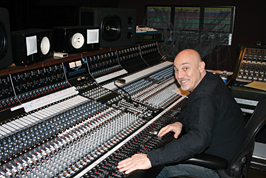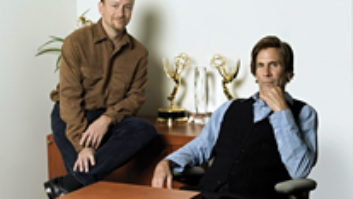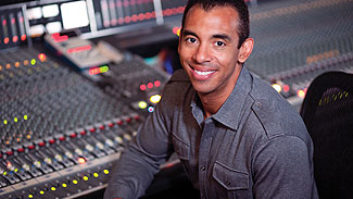
Joe Chiccarelli at Blackbird during tracking sessions for The Raconteurs latest release
Photo: Donny Emerick
More and more L.A.-based rock producers, engineers and mixers are doing projects in Nashville studios these days, not only because Music City boasts a plentitude of top-flight facilities, but also because the musical climate has become far more diverse — and inviting — in recent years.
“Nashville is not about cowboy hats anymore,” says Joe Chiccarelli, who recorded the White Stripes’ Icky Thump and The Raconteurs’ Consolers of the Lonely in Studio D at John McBride’s Blackbird Studios; he also spent a couple of weeks in the same room doing overdubs for My Morning Jacket’s new Evil Urges (which was tracked at Avatar in New York City). “Nashville today is like Seattle was in the ’90s — there’s just a really strong community vibe,” he continues. “And I can’t say that really existed 10 years ago; now, it’s so much more open, with a great alternative music scene. It’s not the best place in the world for a vegetarian to be, but other than that, it really feels like a town to make music in.”
On a practical level, Chiccarelli also gives Nashville high marks. “Along with the great studios and musicians, the techs are there, the cartage companies are there — all the support services. So that makes it a really easy place to make music.”
If he’s crazy about Nashville in general, Chiccarelli is especially crazy about Blackbird. McBride recently installed an API board in D, putting the room even more in Chiccarelli’s sweet spot. There’s also an API in Studio A, where he mixed the Stripes.
“Any opportunity to bring a project there, I’m into it,” he enthuses. “The rooms sound great, they have multiples of every piece of gear known to mankind and everybody who works there seems excited to be there. It’s like the spirit the L.A. studios had in the ’80s. So it’s really a healthy atmosphere. John will walk into the studio one day with a 1937 Martin guitar, and say, ‘I hear you guys needed an acoustic guitar; here’s this one.’”
Like pretty much every musician and studio pro who’s worked at Blackbird, Chiccarelli had his mind blown by the massive amount of gear collected by McBride, a self-described Beatles fanatic. “John’s a total gear nut,” Chiccarelli marvels. “He just bought up a whole bunch of sets of old Gretsch round-badge drum kits. Anything you need, he has it there. It got to be a running joke with me and my assistants during the Raconteurs project: I’d ask for the most obscure piece of gear I could think of, and every time they’d have a couple of them. He may have the largest collection of tube microphones in the world — like 45 U47s, just crazy stuff. He just opens up his lockers, and says, ‘Go for it.’ There’s a spirit in that whole complex. There’s something about it that makes you want to do your best.”
Meanwhile, engineer/mixer Mike Piersante is finalizing the mixes on album projects with B.B. King and John Mellencamp at T Bone Burnett’s Electro Magnetic facility in L.A., his usual haunt. Then it’ll be off to Nashville to hook up with Burnett for a week of tracking with Elvis Costello. They’ll be working in a room that is practically their home away from home: Studio A, the big tracking room at Garth Fundis’ righteously old-school Sound Emporium. Piersante has logged countless hours there, recording the soundtracks to O Brother, Where Art Thou?, Cold Mountain and Walk the Line, along with album projects with bluegrass legend Ralph Stanley and the uncompromising, utterly beguiling Robert Plant & Alison Krauss collaboration, Raising Sand.
“The Sound Emporium staff is great, and everything we’ve done there has had great results, so it’s hard to not go back to what you know,” says Piersante. “They’ve put in a Neve VR since the last time I was there, but we very rarely track through the board anyway, no matter what room we’re in. I don’t know whether it’s superstition or what, but we love the vintage Neve stuff so we’ll often rent modules and use those as our preamps and EQs, and monitor back through the studio’s console. API is another exception — we don’t have any problem tracking through one of those. What we like is a really simple signal path with minimal stuff in the way, which is a good way to capture everything.”
As with the previous Nashville projects, Burnett and Piersante will choose the pieces from their own collections of gear and instruments “to complement what the studio has,” Piersante says. “When we track, an important part of it is to use some of our equipment — T Bone’s guitars and amps, some of my old mics — that you’re not gonna find in a typical studio.” But this precious cargo no longer travels without a chaperone. That practice ended after a series of mishaps, including the gouging of a beautiful old amp by a forklift. Instead, Burnett’s trusted guitar tech (and much more), Paul Ackling, oversees the loading into a well-cushioned truck and drives the gear himself between the two cities.
They always rent a few pieces of gear locally as well, including an all-important Studer 24-track. “People ask why we still cut to tape, but no one’s complained about the way our stuff sounds, and it seems like it’s always been worth it,” Piersante explains. “At the same time, it’s hard to deny the flexibility of digital, so we’ll normally take our tapes and carefully transfer them, with really good converters and clocks to a digital audio workstation and work from there on edits. Sometimes we’ll even do vocals in the box. And then we’ll mix out of the box, one-to-one, and do all of our treatment on an analog console, mixing back to quarter-inch tape. We go 30 ips on an Ampex ATR 102. So we start out on tape and end on tape, and that’s what we deliver to the mastering house.”
When I ask Piersante if he realized what a special record Raising Sand was while he was working on it, he replies, “I gotta tell you with the ultimate amount of sincerity that nearly every project I do with T Bone has that feeling to it. A lot of it is because of the type of artist he brings in. It’s a privilege to work with B.B. King, Ralph Stanley, John Mellencamp, Alison and Robert, obviously. So every session has that feeling of history being made. I’m really proud to be here and be part of it. But as far as commercial success goes, I don’t have a good handle on that.”
Informed that Raising Sand has been certified Platinum, Piersante says, “Wow — no kiddin’. Someone should be sending me a plaque then, I guess.”
Send L.A. news to [email protected].


